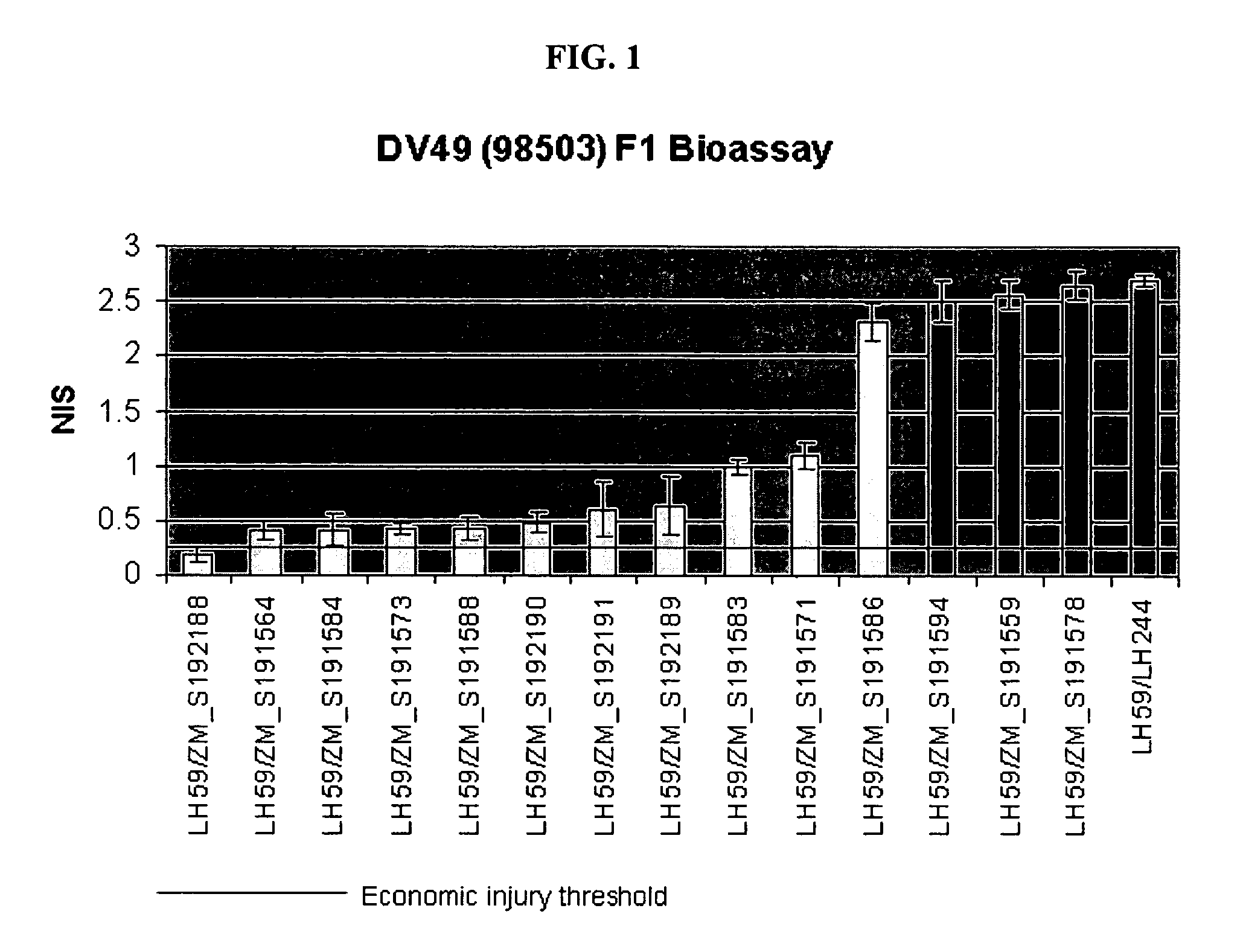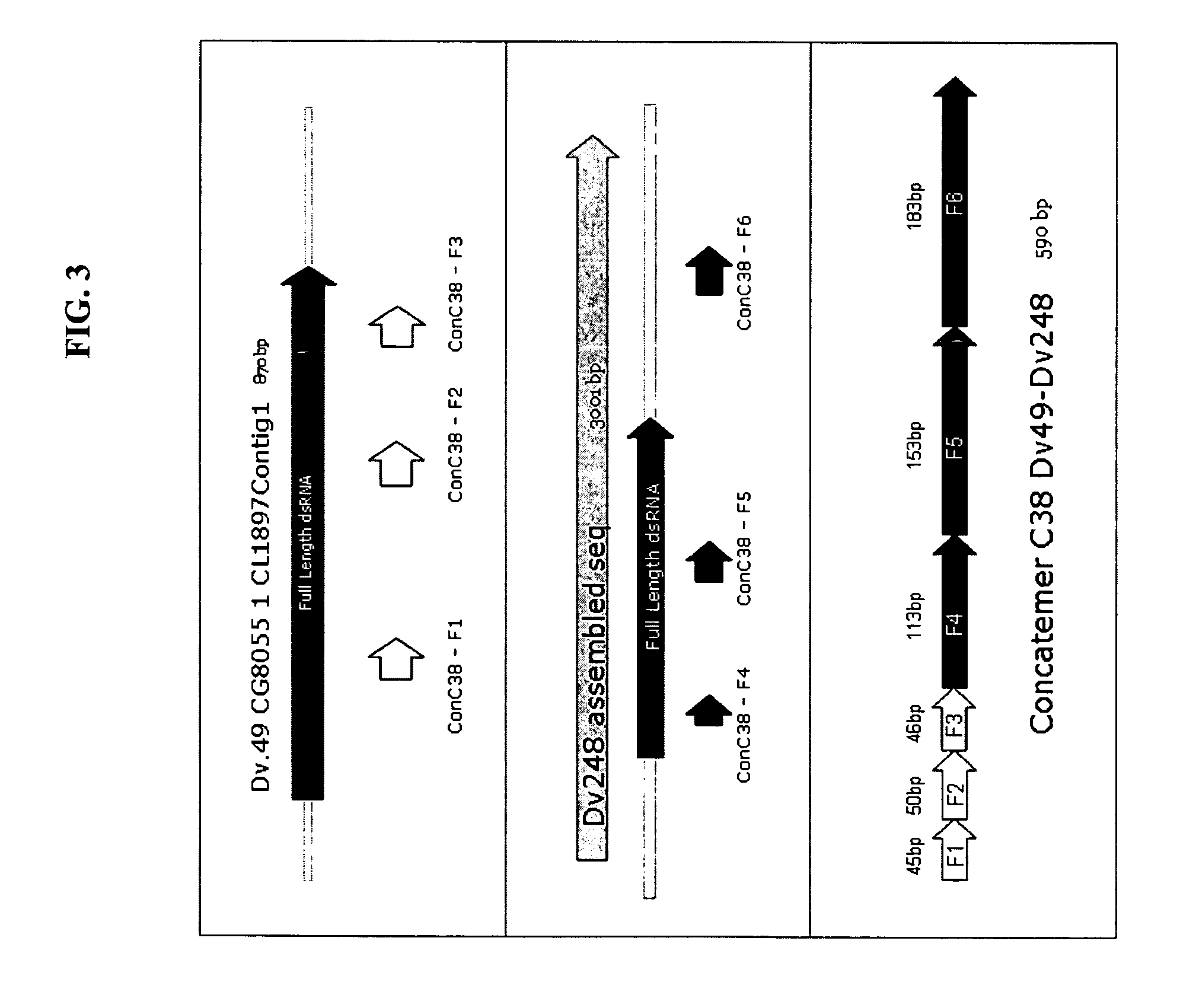Methods for genetic control of insect infestations in plants and compositions thereof
a technology of insect infestation and genetic control, applied in the field of recombinant dna technologies, can solve problems such as insect death
- Summary
- Abstract
- Description
- Claims
- Application Information
AI Technical Summary
Benefits of technology
Problems solved by technology
Method used
Image
Examples
example 1
Identification of Target Nucleotide Sequences For Preparation of dsRNA Useful for Controlling Corn Rootworms
[0193]Corn rootworm cDNA libraries (LIB149, LIB 150, LIB33027, LIB3373) were constructed from whole larvae, pupae and from dissected midgut sections, and nucleotide sequence information was obtained (see Andersen et al., U.S. patent application Ser. No. 10 / 205,189 filed Jul. 24, 2002, incorporated herein specifically by reference in its entirety). In addition, cDNA libraries were constructed from whole larvae at different developmental stages and at different times within each developmental stage in order to maximize the number of different EST sequences from the Diabrotica species. Libraries LIB5444 and LIB5462 were constructed respectively from mRNA pools obtained from first (1 gram) and third (2.9 grams) instar Western Corn Rootworm larvae. Harvested insects were rapidly frozen by insertion into liquid nitrogen. The insects were ground in a mortar and pestle maintained at o...
example 2
Insect Feeding Bioassays
[0237]Samples of double stranded RNA (dsRNA) were subjected to bioassay with a selected number of target pests. The dsRNA was prepared from sequences identified according to Example 1 using either a full contig sequence in the case of SEQ ID Nos: 1-6, or a sequence amplified from the assembled contig using the primer pairs as set forth in the sequence listing. Varying does of dsRNA were applied as an overlay to corn rootworm artificial diet according to the following procedure. Diabrotica virgifera virgifera (WCR) eggs were obtained from Crop Characteristics, Inc., Farmington, Minn. The non-diapausing WCR eggs were incubated in soil for about 13 days at 24C, 60% relative humidity, in complete darkness. On day 13 the soil containing WCR eggs was placed between #30 and #60 mesh sieves and the eggs were washed out of the soil using a high pressure garden hose. The eggs were surface disinfested by soaking in LYSOL for three minutes, rinsed three times with steril...
example 3
Results of Insect Feeding Bioassays
[0242]Artificial diet sufficient for rearing corn rootworm larvae was prepared by applying samples of double stranded RNA sequences identified as described in Example 1 using bioassays carried out as described in Example 2. Corn rootworm larvae were typically allowed to feed on the diet for twelve days and mortality and stunting monitored in comparison to rootworms allowed to feed only on negative and positive control diets. The results of the studies confirmed significant levels (p<0.05) of larval stunting and / or mortality using dsRNAs containing portions sequences homologous to a variety of different gene classes. The sequences and vectors yielding significant stunting and / or mortality and the corresponding SEQ ID NO for the sequence expressed as a dsRNA are given in Tables 1-5 below.
[0243]
TABLE 1dsRNA Constructs Demonstrating Significant Stunting and / or Mortality in Effectin Insect Feeding Bioassays with Southern Corn Rootworm or Western Corn Ro...
PUM
| Property | Measurement | Unit |
|---|---|---|
| temperature | aaaaa | aaaaa |
| temperature | aaaaa | aaaaa |
| temperature | aaaaa | aaaaa |
Abstract
Description
Claims
Application Information
 Login to View More
Login to View More - R&D
- Intellectual Property
- Life Sciences
- Materials
- Tech Scout
- Unparalleled Data Quality
- Higher Quality Content
- 60% Fewer Hallucinations
Browse by: Latest US Patents, China's latest patents, Technical Efficacy Thesaurus, Application Domain, Technology Topic, Popular Technical Reports.
© 2025 PatSnap. All rights reserved.Legal|Privacy policy|Modern Slavery Act Transparency Statement|Sitemap|About US| Contact US: help@patsnap.com



